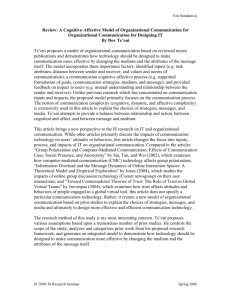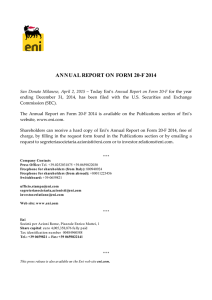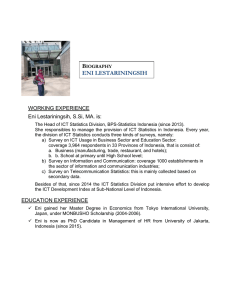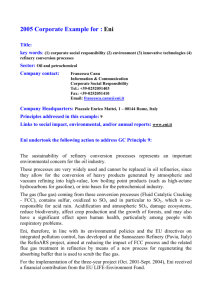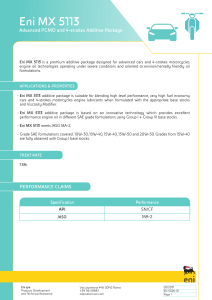Eni S.p.A Industry 4.0: Supercomputer for Digital Geoscience
advertisement
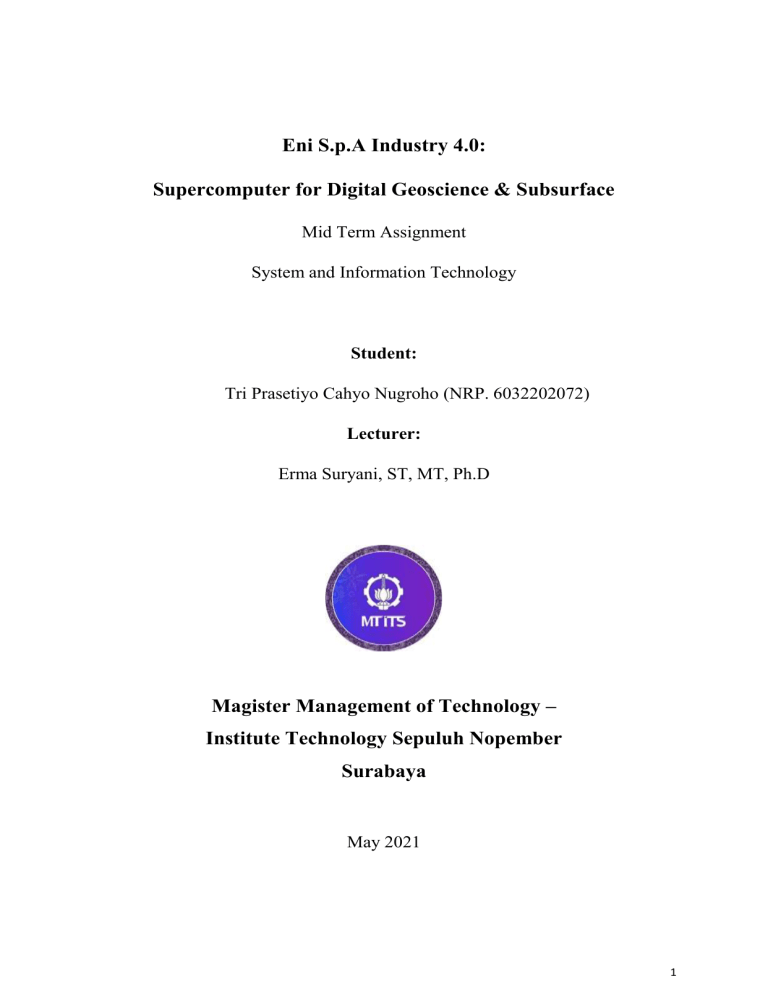
Eni S.p.A Industry 4.0: Supercomputer for Digital Geoscience & Subsurface Mid Term Assignment System and Information Technology Student: Tri Prasetiyo Cahyo Nugroho (NRP. 6032202072) Lecturer: Erma Suryani, ST, MT, Ph.D Magister Management of Technology – Institute Technology Sepuluh Nopember Surabaya May 2021 1 Table of Contents Table of Contents ....................................................................................................................... 2 Executive Summary ................................................................................................................... 3 1. Introduction ..................................................................................................................... 4 2. Smart Industry 4.0 for Circular Economy ....................................................................... 8 3. HCP 5 SUPERCOMPUTER IMPACT FOR GEOSCIENCE AND SUBSURFACE BUSINESS ......... 11 4. Analyse Opportunities Industry 4.0 .............................................................................. 19 5. Conclusion ..................................................................................................................... 23 6. Reference & Disclaimer ................................................................................................ 26 2 Executive Summary Industry 4.0 is assumed to yield extensive industry-spanning opportunities. However, exploiting these opportunities requires a targeted implementation of Industry 4.0. The purpose of this report is to generate a deeper understanding of relevant implementation action that has been taken and planned by Eni S.p.A as one of the biggest oil and gas producer company. The report is semi-structured in-depth expert review as the source of empirical data. The reviews were conducted the Digital Initiative that has been taken by Eni as a Company that start to adopt Industry 4.0 for the Oil & Gas Industry. The report reveals relevant and targeted aspects for Industry 4.0 implementation: the development of Industry 4.0-specific know-how, securing financial resources, integrating all business approaches into the implementation process and establishing an open-minded and flexible corporate culture. Further aspects include comprehensive planning processes, cooperation with external partners, proper handling of data interfaces, interdisciplinary communication, an adaptable organizational structure and data security. The report is limited to Eni S.p.A enterprises and might have a different standard approach from other industries and country. The study supports the Company to effectively implement Industry 4.0 within their organizations and consequently benefit from Industry 4.0 and derives recommendations for future research. The report finds that, implementation of Industry 4.0 thru Hyper Super Computer would make better planning of decision making which is a critical part of investment management. Having a proper set up of and faster study using the HPC5, allows Eni S.p.A to accelerate all business process, as well as eliminate any potential turnover of operations and production. This Digital Impact also speed up the Company transformation into a Green Energy Producer that shall be CO2 free in 20250. At the end of the report it is also shown that the financial growth will also have a positive impact by having the Industry 4.0 adoption in Digital Technology and Information System. 3 1. Introduction Eni is a global energy company, engaged in the entire value chain: from the exploration, development and extraction of oil and natural gas, to the generation of electricity from cogeneration and renewable sources, traditional and biorefining and chemicals, and the development of circular economy processes. Eni extends its reach to end markets, selling gas, electricity and products to retail and business customers and local markets. Both CO2 capture and storage initiatives and forest conservation projects (REDD+ initiatives) will be implemented to absorb residual emissions (Eni, 2018). Company mission is inspired by the UN 2030 Agenda, which was launched in September 2015, when more than 150 world leaders met to support global development, promote human wellbeing and protect the environment. The UN 2030 Agenda is an action plan that incorporates 17 Sustainable Development Goals, embracing all aspects of social, economic and environmental development in an organic and integrated way. Claudio Descalzi, Eni’s Chief Executive Officer stated that: “Eni is determined to be a force for good in contributing to the achievement of the UN’s Sustainable Development Goals and bring about a just transition, ur global presence makes us acutely aware of the challenges the world faces today: our new mission sets out the values and principles which will drive us in helping tackle those challenges” . The new mission is giving the highest recognition to the principles that are the foundation of the company’s business model, which focuses on long-term investments both in operational and in social terms and looks beyond short-term profit priorities. It builds sustainability into all of the company’s activities. Aside from climate and the environment, it has a particular focus on the development of people and recognizes diversity as a valuable opportunity. 4 Figure 1. Corporate Mission The values that inspire our new mission are reflected in our business model, itself based on three pillars of long-term carbon neutrality, operational excellence and the creation of alliances for local development. Visit the Just Transition section to find out more or explore examples of current local development activities and projects in the Global Presence section. The new Mission goes beyond the previous version, adopted in 2016, updating it and reinforcing it. Approved by the Board of Directors, it will serve as a set of principles for the company and its over 30,000 employees across 67 countries. 5 Figure 2. Corporate Mission “Research”, “development” and “technology” have always been imprinted in Eni's DNA. Eni has grown and developed also thanks to a strong focus and investment in these areas, which today are even more a priority in the energy transition path. Digital transformation is part of this path, to ensure long-term competitiveness and sustainable growth by targeting Eni's strategic objectives. The creation, in the summer of 2020, of the new Technology, R&D, Digital function gave even greater impetus to innovation by creating the conditions for Eni's research and development and technological and digital innovation to be essential levers to create value, transform its business and grow, thanks to common strategic objectives, maximization of synergies and their rapid implementation in the field on an industrial scale. In particular, the Digital & Information Technology unit stands alongside business to achieve strategic and sustainability objectives, with a transversal and integrated approach, from the promotion of innovation and the introduction of new digital solutions to their 6 industrialization, with a strong focus on aspects of infrastructure resilience, operational excellence and security. Figure 3. Corporate Value Foundation Eni Digital Business Unit was created at the end of 2018 with the goal of defining a digital strategy and carrying out a comprehensive transformation of all aspects of the company. This division identifies digital initiatives and, at the same time, promotes open innovation channels in order to expand the contribution of both academic and entrepreneurial centers of excellence in Italy and abroad. What Eni does to develop advanced analytic tools is truly an innovative approach. Thus, the digital transformation in the field of drilling (Drilling and completion), for example, is based on three factors: artificial intelligence to support production decision-making, virtual reality for modeling, and advanced robotics for automation of operations. This transformation is already helping to achieve three main goals: improving the safety of the facility, performance improvement, and improved well planning. 7 Figure 4. Eni in Numbers 2. Smart Industry 4.0 for Circular Economy Too often, transitioning to a circular business model is viewed primarily as an investment in the company’s image. While there surely is an advantage in that sense, this type of thinking misses the point. Going circular in industrial settings means saving a considerable amount of time, raw materials and money, while opening up all kinds of opportunities to innovate, diversify and develop additional revenue streams. Figure 5. Key Elements for Digitalization 8 Today’s connected/smart industry solutions allow companies to easily monitor, optimize and improve their production processes. Industrial Internet of Things (IIoT) devices such as sensors and connected systems provide decision-makers with new sets of data, shedding new insights on KPIs, primary products, by-products and waste management. By taking advantage of these tools, companies can increase their competitiveness along their entire value chain, ultimately leading to higher profits, all while helping the environment. As explained by the Ellen MacArthur Foundation, IoT and smart devices in industrial settings help companies unlock the circular economy potential thanks to three main value drivers: Knowledge of the location of the asset Knowledge of the condition of the asset Knowledge of the availability of the asset Having an overview on these data in real time is of immense value to businesses. For instance, knowing the location of an asset allows for optimized routes for loading/unloading, maintenance and storage of spares. Knowing the condition of an asset – let’s say, that of an industrial machine monitored by a connected device – can lead to high uptime, as it allows for predictive maintenance instead of routine interventions. Parallelly, downtime is quickly detected and handled more efficiently. Thirdly, knowing the availability of an asset allows companies to optimize energy and other resources like raw materials based on usage patterns. But the sky really is the limit: It all comes down to using the new insights to rethink the production process and set more granular KPIs. Tapping into these sets of data, which were seldom available before the advent of IoT, empowers businesses to perform all kinds of optimizations. What’s more, IT companies such as IBM, Oracle and SAP are also offering supply chain analytics solutions to analyze data and further identify optimization opportunities. Going circular is not just about saving money. It also opens new and exciting business opportunities for companies to increase their competitiveness and identify additional revenue streams. 9 For instance, a growing number of companies are transitioning to circular business models by offering turnkey solutions to their existing customers. It is the case of PaaS, “product-as-aservice” business model, in which businesses offer clients a subscription to use their goods, taking charge of the entire product lifecycle: maintenance, repairing and recycling. Due to their convenience, these solutions are highly attractive for both consumer and business customers. After the initial investment, they can be more profitable for manufacturers, as they retain ownership of the products all while gathering data about their usage, which is used to further optimize design and production processes. Similarly, companies can develop tighter relationships with customers by providing the added value of a consultancy service. Improving products and processes and creating long-lasting relationships with end customers is everything companies need to future-proof their businesses in a highly volatile global market. As consumers, we are already experiencing the growing success of the sharing economy, in which goods are not owned, but leased for a period of time. This type of business model maximizes the use of assets, practically eliminating downtime. A 2015 PwC study forecasted that global revenues for the sharing economy in five key sectors have the potential to increase from approximately $15 billion USD in 2015 to $335 billion USD by 2025. The growing success of companies such as AirBnb, Uber, WeWork and others show that the general public is highly interested in shared solutions, especially in urban settings where space is scarce. High inventory yields will provide an enterprise with stockout protection with wide variety and selection, short lead time since the material ready on the shelf, lower cost per unit purchased, large lot production and transportation economics and potential inflation hedging. Conflicting with low inventory yield, that would allow low holding cost and enterprise will be very focus on the quality of execution in order to eliminate error due to limited stock. A number of companies around the world have seized the opportunities offered by the Industry 4.0 to transition to the circular economy, even at an enterprise level. Whirlpool Corporation, for instance, integrated energy monitoring equipment down to the individual machine level in their production plants to obtain an accurate picture of energy usage. In one of their plants, this has led to reducing consumption by 750,000 kWh per year. 10 Employees in another Whirlpool facility noticed one of their processes was consuming more energy due to heat loss, so they implemented thermal blankets, a move that saved the company an additional 1 million kWh per year. The company is also collecting data on material composition in a global online tool that’s used by engineers to make sustainable choices at the design level. This enhancement helps fulfill their commitment to use 100% recycled content on major plastic components by 2025. Figure 6. Digitalization Enhancing Value 3. HCP 5 SUPERCOMPUTER IMPACT FOR GEOSCIENCE AND SUBSURFACE BUSINESS HPC5 is a set of parallel computing units with a peak processing power of 51.7 petaFlops. Combined with the supercomputing system in operation since 2018 (HPC4), the peak computational capacity of the infrastructure totals 70 petaFlops: that is, 70 million billion mathematical operations performed in a single second. Its full name is High Performance Computing - layer 5. It is our latest-generation supercomputer. In June 2020, it entered the TOP500 list, ranking as the world’s sixth most powerful supercomputer, and the most powerful in Europe. It is still the leader among non-governmental computers. Again in June 2020, it entered the Green500 special list, taking the same position as the world’s sixth most energy efficient supercomputer. Ignoring experimental computers and considering only true supercomputer systems with a consumption level of over 1MW, it has ranked as the secondbest computer in the world for energy savings. A single watt of electricity enables it to 11 perform almost twenty billion operations per second. The performance level of this computer means it can use extremely sophisticated in-house algorithms to process subsoil data. The geophysical and seismic information we collect from all over the world is sent to HPC5 for processing. Using this data, the system develops extremely in-depth subsoil models, and on the basis of these, we can determine what is hidden many kilometres below the surface: indeed, this is how we found Zohr, the largest gas field ever discovered in the Mediterranean. Figure 7. HPC5 Super Computer While the production of gas and oil continues in the energy industry's traditional geographic areas, the next frontier of exploration is shifting towards increasingly remote places, and going deeper and deeper underground. And all this is occurring while the demand for global energy calls for rapid response times. In this environment, identifying new resources and bringing them into production as fast as possible becomes a serious challenge. The use of a supercomputer like HPC5 enables us to increase the accuracy of our studies of underground rocks, reducing the margin for error in prospecting operations and decreasing time-to-market, or the time between the identification of the field and the launch of production. This also has a positive impact on sustainability, as it reduces waste, both in terms of energy and resources. 12 HPC5 is a computing cluster, or in other words, a set of computers that work together to multiply overall performance. The power of this supercomputer is three times that of its predecessor, HPC4. To keep energy consumption to a minimum, a hybrid architecture has been selected to optimise performance: as such, HPC5 and HPC4 use GPU computation (graphic processing units - GPUs - optimised for calculating large volumes of data in parallel), and these are very energy efficient. Indeed, with just one watt of power, a GPU can carry out over 10,000 million billion mathematical operations. In addition, every single computer has two CPU sockets; HPC4 also has two sockets for graphics accelerators, while HPC5 has four sockets. In total, the machine has access to more than 3400 computing processors and 10,000 graphics cards. This type of hardware, coupled with our proprietary algorithms, enables us to produce three-dimensional models of the subsoil that lie at a depth of 10-15 km, with a surface area of hundreds of km2 and a resolution of a few dozen metres. Once the hydrocarbons have been found, our geologists again use supercomputers to model the deposits and optimise their exploitation. Equally important was the contribution to the launch of the new EST reactor, which converts heavy refining residues into high quality light products. Moreover, from a strategic point of view, the memory of this computing behemoth stores the data of all the explorations and all the fields discovered by Eni in over sixty years of history, and this provides the basis for the development of the best methods for extracting the hydrocarbons that these areas still contain. Figure 8. Seismic Geodata Imaging 13 HCP5 performed the simulation and done within 9hours, others done in 15days. Zohr Field: the largest reservoir in Egypt and Mediterranean Sea and only need 2years from Discovery to Production (Accelerate the FID – Financial Investment Decision). Enhancement research that can be taken from HPC5 installation: A single watt of electricity enables it to perform 20billions operations per second. Sophisticated in-house algorithms to process subsoil data from geophysical and seismic information to determine what is hidden many kilometers below the surface/seabed. Increase the accuracy of its studies of underground rocks & produce 3-dimensional models of the subsoil that lie at a depth of 10-15 km. Reducing the margin for error in prospecting operations. Decreasing time-to-market, speeding up decision making (FID). A positive impact on sustainability, as it reduces waste, both in terms of energy and resources. Acceleration of the company’s transformation and the development of new energy sources and related processes; the generation of energy from the sea, the magnetic confinement fusion, as well as other climate and environmental technologies thru algorithm operations and solution. Figure 9. Selective Capex and High Value Portfolio 14 But HPC5 and HPC4 are not just used to discover new deposits, to model existing discoveries or to improve refining, but will also be used more and more for the energies of tomorrow The two supercomputers run original programs for research into magnetic confinement fusion: development of superconducting magnets in the joint Eni-CNR research centre in Gela and the study of plasmas in the research centre in San Donato Milanese. This is where the theoretical modelling takes place of the photoactive molecules and polymers that are at the core of new technologies for capturing solar: OPV organic solar panels and LSC luminescent solar concentrators. Lastly, Eni supercomputers are used to build advanced mathematical models combining meteorological and marine information with information on the behaviour of Marenergy technologies, such as ISWEC or Power Buoy, which generate electricity from wave motion. Meanwhile, detailed weather and climate models of the Arctic on a continental scale are developed at the joint Eni-CNR research centre in Lecce – with the essential support, of course, of the computing power of our supercomputers. Finally, the supercomputer will be fundamental in the development of our artificial intelligence projects, a new line of research that we are working on with IBM. Figure 10. Cash Flow Growth HPC5 helps us to progressively improve our environmental performance, because increasing the efficiency of what we do allows us to reduce waste: in terms of energy, resources and time. In additions, 10-15% of the power provided to HPC4 is delivered by a photovoltaic system with 1MW of power, consisting of 2968 solar tracker photovoltaic modules distributed 15 over 106 strings, part of our Progetto Italia initiative. Moreover, courtesy of its special environmentally-friendly design, the Green Data Center that houses the supercomputer enables us to save around 4500 tons of CO2 per year compared to a normal data centre. Today, for 92% of the year, the machines are cooled via the low-speed circulation of air, thanks to a system of pipes that intercepts air from the surrounding environment and filters it, before returning it cleaner than before. Accordingly, the use of air conditioning is minimal. Figure 11. Time to Market Efficiency The main goal of all our digital geoscience technologies is simple yet demanding: going faster. By speeding up our processing of the seismic and geological data we get from subsoil surveys, we not only shorten times of modelling fields, but also increase their resolution, because we can use new and increasingly powerful algorithms. To reach this goal, we focus on integrating and standardising data from the whole Upstream chain, within the special architecture of our supercomputer. From the great raft of information we gather, we develop useful simulators of our own, which rely on all the geological and geophysical skills our specialists working around the world. It is a challenging road, but thanks to these continuous efforts we can count on excellence in operations and make a difference. Both hardware and software are constantly updated to remain in step with the latest technological developments. This lets us support a “fast-track” approach in which exploration, engineering, development and supply are also improved. This speeds up the launch of projects and reduces costs and 16 risks. Exploration activity achieved excellent results in 2020 despite the capex reduction of approximately 50% from 2019. Added 400 mmboe of new resources at a competitive cost of 1.6 $/barrel. Exploration is still a distinctive approach of Eni’s upstream model, maintaining a solid track record of production replacement with resources discovered equal to over 6 bboe in the last seven years, well above than the cumulative production in the period, at a unit cost lower than 1.5 $/barrel. Achieved near-field exploration successes ensuring a fast contribution to cash flows. In this context, main near-field discoveries were in Egypt and then in Tunisia, Norway, Algeria and Angola, where the Ago- go appraisal well estimated 1 billion boe in place. Significant results reached also in frontier exploration area with the Mahani gas and condensate discovery in the onshore of the Emirate of Sharjah (UAE), just one year since the signing of the contracts, the appraisal of the Ken Bau field offshore Vietnam, which allowed to outline a giant field, and the Saasken discovery, offshore Mexico, which strenght Eni’s activity in the Country. These exploration successes create opportunities to early monetization fuelling the dual exploration model using the HPC-5 Super Computer for iteration of data seismic. Figure 12. Time to Market Efficiency Starting from 2016, Eni was among the first in the industry, to committ to targets aimed at improving the performance related to operational GHG emissions of the operated assets, with specific indicators showing the progress achieved so far in terms of reduction of GHG 17 emissions into the atmosphere, use and consumption of energy resources from primary sources and production of energy from renewable sources. In addition to these, in 2020 new medium and long-term targets, accounted for on an equity basis, were defined and in 2021 they have been relaunched during the presentation of the strategy, in which Eni announced the target of net zero emissions (Scope 1, 2 and 3) by 2050. Below are Eni’s main long-term objectives and the performance of the associated indicators: Net-zero Carbon Footprint upstream by 2030: the indicator considers Scope 1+2 emissions from all upstream assets, op- erated by Eni and by third parties, net of carbon sinks, which in 2020, was down by 23% compared to 2019 due to both the pro- duction declines occured in relation to the health emergency and the offsetting through forestry credits equal to 1.5 million tonnes of CO2eq. Net-zero GHG Lifecycle Emissions by 2050: the indicator refers to all Scope 1, 2 and Scope 3 emissions associated with Eni activities and products, along their value chain, net of carbon sinks and in 2020 it was down by 13% mainly due to the decrease in production and sales in all sectors related to the health emergency. Zero Net Carbon Intensity by 2050: the indicator is calculat- ed as the ratio between absolute net GHG emissions (Scope 1, 2 and 3) along the value chain of energy products and the amount of energy they contain. In 2020 it was essentially sta- ble as the decrease in emissions across all sectors was ac- companied by a proportional decrease in production related to the decline in activities due to the health emergency. 18 Figure 13. Roadmap to Digitalization 4. Analyse Opportunities Industry 4.0 The Company has adopted comprehensive classification criteria for the estimate of proved, proved developed and proved undeveloped oil and gas reserves in accordance with applicable US Securities and Exchange Com- mission (SEC) regulations, as provided for in Regulation S-X, Rule 4-10. Proved oil and gas reserves are those quantities of liquids (including condensates and natural gas liquids) and natural gas which, by analysis of geoscience and engineering data, can be estimated with reasonable certainty to be economically producible from a given date forward, from known reservoirs, under existing economic conditions, operating methods, and government regulations prior to the time at which contracts providing the right to operate expire, unless evidence indicates that renewal is reasonably certain. Oil and natural gas prices used in the estimate of proved reserves are obtained from the official survey pub- lished by Platt’s Marketwire, except when their calculation derives from existing contractual conditions. Prices are calculated as the unweighted arithmetic average of the first-day-of-the-month price for each month within the 12-month period prior to the end of the reporting period. Prices include consideration of changes in exist- ing prices provided only by contractual arrangements. 19 Figure 14. Renewable Energy Growth Engineering estimates of the Company’s oil and gas reserves are inherently uncertain. Although authoritative guidelines exist regarding engineering criteria that have to be met before estimated oil and gas reserves can be designated as “proved”, the accuracy of any reserves estimate is a function of the quality of available data and engineering and geological interpretation and evaluation. Consequently, the estimated proved reserves of oil and natural gas may be subject to future revision and upward and downward revisions may be made to the initial booking of reserves due to analysis of new information. Proved reserves to which Eni is entitled under conces- sion contracts are determined by applying Eni’s equity interest to total proved reserves of the contractual area, until expiration of the relevant mineral right. Eni’s proved reserves entitlements under PSAs are calculated so that the sale of production entitlements cover expenses incurred by the Group for field development (Cost Oil) and recognize a share of profit set contractually (Profit Oil). A similar scheme applies to service contracts. 20 Figure 15. 4Year Plan Energy Transition In 2020, natural gas sales in Italy and in the rest of Europe amounted to 7.68 bcm, down by 0.94 bcm or 10.9% from the previous year. Sales in Italy amounted to 5.17 bcm down by 5.8% compared to 2019, the reduction was mainly due to lower volumes marketed at small and medium enterprises and resellers segments; the reduction reported in the residential segment was mitigated by the positive weather effect mainly in the last quarter of the year. Sales in the European markets (2.51 bcm) reported a reduction of 19.8% or 0.62 bcm compared to 2019. In France, sales decreased by 22.7% due to lower volumes marketed to industrial customers. In Greece and Slove- nia sales were substantially in line with the comparative period. In 2020, retail power sales to end customers, managed by Eni gas e luce and the subsidiaries in France and Greece, amounted to 12.49 TWh, an increase by 14.4% from 2019, due to growth of retail customers portfolio (up by 270,000 customers vs. 2019) and higher volumes sold to the retail and industrial segments in Europe. 21 Eni’s power generation sites are located in Brindisi, Ferrera Erbognone, Ravenna, Mantova, Ferrara and Bolgiano. As of December 31, 2020, installed operational capacity of Enipower’s power plants was 4.6 GW. In 2020, thermoelectric power generation was 20.95 TWh, substantially in line compared to 2019. Electricity trading (17.09 TWh) reported a decrease of 4.2% from 2019, thanks to the optimization of inflows and outflows of power. In 2020, power sales in the open market were 25.33 TWh, representing a reduction of 10.4% compared to 2019, due to economic downturn. Figure 16. Enhanced remuneration policy We have defined an innovative dividend policy, based on a fixed component, which will be reassessed going forward based on the achievement of Eni’s indus- trial objectives, and a variable component linked to the scenario, in order to adapt the dividend to market volatility, while the buy-back has been suspended. Thanks to these actions, we were able to generate an adjusted cash flow of €6.7 billion, able to fund 100% of our organic capital expenditure, which were revised to €5 billion, leaving a surplus of €1.7 billion despite the large impact of the crisis on our cash receipts which contracted by around €6 billion compared to the forecasts at the beginning of the year. 22 5. Conclusion In a year like no other in the history of the energy industry, Eni has proven the robustness and flexibility of its business model by reacting swiftly and effectively to the extraordinary crisis context, while progressing the Company’s irreversible path for the energy transition. In the space of a few months after the outbreak of the pandemic we reduced capital spending and limited the impact of the sharp drop in crude oil prices on the cash flow, strengthening our liquidity and preserving the robustness of our balance sheet. The upstream business is strengthening its recovery, while our businesses in the production and sale of decarbonized products achieved excellent results in the year, driven by a 17% Ebit increase from Eni gas e luce, a 130% increase in biorefining processing and 1 GW of new solar and wind generation capacity already installed or sanctioned. We laid foundations for strong growth in renewables by entering two strategic markets, the US and the Dogger Bank wind project in the UK’s North Sea offshore wind market, which will be the largest in the world in the sector. Through leveraging the actions we put in place, our 2020 adjusted cash flow of €6.7 billion was able to finance our capex, with a surplus of €1.7 billion. Net borrowings (before IFRS 16) are at the same level as at the end of 2019, and leverage is at around 30%”. Management took decisive actions according to three priorities: Health and safety of our people and asset integrity: implemented initiatives to safeguard each of the 60 thousand people that work in Eni and with Eni, in all the work places and operational sites. Very quickly, smart working was adopted by 99% of Eni employees in the main offices and by 70% of people engaged in our operational sites. These measures allowed to ensure continuity, without operational interruptions and asset integrity. Robustness of balance sheet: during the pandemic peak, management took decisive actions to increase the fi- nancial resiliency and strengthen the balance sheet, defining clear priorities in cash allocation. The Company is set to resume growing once the macro backdrop normalizes. Revised the Company’s strategy and plans for the shortto-medium term leveraging on a reduction of €8 billion in the outlays for expenses and capital expenditures in the two-year period 2020-2021, more exposed to the downturn, with the subsequent reshaping of the growth profile of production and the definition of a dividend policy based on a fixed component, subject to a continuous reevaluation process, following the achievement of certain Eni’s industrial targets and a 23 variable component indexed to the scenario, in order to adapt the dividend to market volatility; the share buy-back program is temporarily suspended. Organizational structure: in June 2020, Eni created a new organizational setup by establishing two business groups: the Natural Resources business which has the task of valorizing the Oil & Gas portfolio in a sustainable way and of managing the energy efficiency activities, the projects of CO2 capture; and the Energy Evolution business which has the task of managing the evolution of businesses of power generation, manufacturing and marketing of products from fossil to bio, blue and green. The two business groups will work in synergy with R&D and digitalization department to realize Eni’s plans and achieve the decarbonization targets to 2050. Leading energy transition Decarbonization of operations and products to deliver a mix of entirely decarbonized products: Net Zero Emissions at 2050, introducing new targets for net absolute emissions (Scope 1, 2 and 3): -25% at 2030 vs. 2018 and -65% at 2040. Stakeholder Value Creation Enhanced remuneration policy: Dividend floor set at €0.36 per share at 43 $/bbl vs. the previous level of 45 $/bbl 300 mln/year buy-back to re-start at 56 $/bbl. Confirmed buy-back at €400 mln/year from 61 $/bbl and €800 mln/year from 66 $/bbl Exploration & Production Maximizing returns and cash generation by leveraging on the enhancement of the current asset portfolio, exclusively conventional, with lower break even, phased projects, accelerated time-to-market and limited exposure beyond the medium term. Global Gas & LNG Portfolio The expected contracted LNG volume portfolio will be equal to 14 million tons/y in 2024 (up 45% vs. 2020) with a gas equity share higher than 70%. The aforementioned actions will allow to achieve a 2021-2024 cumulative free cash flow of €0.8 billion. Refining & Marketing Focused on the development of biorefinery capacity, expected to almost double to 2 million tonnes by 2024 and further grow to 5-6 million tonnes/y in 2050. 24 Power & Renewables Provide for the synergic development of installed capacity for the production of renewable energy targeting 15 GW by 2030 and 60 GW by 2050 and the enhancement of retail customer base up to exceeding 20 million of customers by 2050 through the selection of areas of expansion in the renewables leveraging on the presence of our customers as well as the development of activities in Eni’s countries of operation. Financial The four-year capex plan focused on high-value fast-return projects, is expected to be €27 billion. This capital plan retains some degree of flexibility because about 55% of capex expected in 2023-2024 remain uncommitted. The 65% of the group capex plan is expected to be focused on the upstream segment and is well diversified geographically thanks to developments in the Middle East, Africa and Mexico. Eni’s capex plan is a high value programme and is resilient even in a challenging scenario. The current portfolio of upstream projects in progress has a break even price of 28 $/barrel by 2024 and an overall IRR of about 18%. Regarding renewables projects the unlevered internal rate of return is between 6 and 9% and, through financing operations, it will be able to reach a double-digit level; while IRR for biorefineries is envisaged at 15%. Figure 17. INDUSTRY 4.0 to Eni Energy Transformation 25 6. Reference & Disclaimer Energy Industry Review (2020), New Supercomputing System HPC5. Retrieved from https://energyindustryreview.com/tech/new-supercomputing-system-hpc5/ Eni Indonesia (2020), Business Review 4YP 2020, Jakarta Eni S.p.A (2020), Digital geoscience: depths of the earth as seen by our supercomputer, Milan. Retrieved from https://www.eni.com/en-IT/operations/digital-geoscience.html. Financial Management Pro (2020). Retrieved from http://financialmanagementpro.com/. Johannes W. V., Daniel K., Julian M. Müller. & Kai-Ingo V. (2020). Lessons Learned from Industry 4.0 Tmplementation in The German Manufacturing Industry. Retrieved from https://www.emerald.com. Jakobsen, M. & Lueg, R. (2014). Balanced Scorecard and Controllability at The Level of Middle Managers - The Case of Unintended Breaches, Journal of Accounting & Organizational Change, 10(4), 516-539. Retrieved from https://www.emerald.com/. Kristin, K., Rahadi A., Priyono, O., Badaruddin, Turnip, E., Hudianto, A., … Fandy, F. (2020). Logistic Monthly Report Period July 2020. Retrieved from https://ext.lims-eni.com/. Laudon, K.C. & Laudon, J.P. (2020). Management Information System: Managing The Digital Firm (16th Ed), New Jersey, Pearson Education, Inc. Luca V (2020). Eni’s Digital Future: that is all about people, once again. Retrieved from https://www.linkedin.com/pulse/enis-digital-future-all-people-once-again-lucavignati/?articleId=6681213996412084224. Disclaimer This document contains forward-looking statements regarding future events and the future results of Eni that are based on current expectations, estimates, forecasts, and projections about the industries in which Eni operates and the beliefs and assumptions of the management of Eni. The information provided in this presentation is for study purpose for the subject of System and Information Technology only and not to be shared and/or distributed out of the forum without approval consent from the Company. 26
